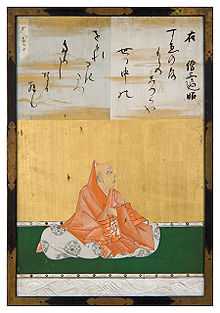Henjō

Sōjō Henjō (遍昭 or 遍照, 816 – February 12, 890) was a Japanese waka poet and Buddhist priest. His birth name was Yoshimine no Munesada (良岑宗貞). Thanks to a reference to him in the preface of Kokin Wakashū he is listed as one of the Six best Waka poets and one of the Thirty-six Poetry Immortals.
Biography
Henjō was the eighth son of Dainagon Yoshimine no Yasuyo, a son of Emperor Kammu who was relegated to civilian life.[1] Henjō began his career as a courtier. He was appointed to the position of kurodo, a sort of Chamberlain of Emperor Nimmyō. In 849 he was raised to the Head of Kurodo (Kurōdonotō). After Emperor Nimmyō died in 850, Henjō became a monk out of his grief.
He was a priest of the Tendai school. In 877 he founded Gangyō-ji (元慶寺) in Yamashina, in the southeast part of Kyoto, but continued to be active in court politics.[2] In 869 he was given another temple Urin-in or Unrin-in (雲林院) in the north of Kyoto and managed both temples. In 885 he was ranked in Sojo and called Kazan Sojo (花山僧正).
He was rumored to have had a love affair with the great female poet Ono no Komachi.
Thirty-five of his waka were included in the imperial anthologies of waka including Kokin Wakashū. In the preface Ki no Tsurayuki criticized him: "he knows how to construct waka, but there is less real emotion. It is like when you see a picture of a woman and it moves your heart". Henjō was famous for the following poem from the Hyakunin Isshu:
Oh stormy winds, bring up the clouds
And paint the heavens grey;
Lest these fair maids of form divine
Should angel wings display,
And fly far far away.
His son, Priest Sosei was also a waka poet and monk.
References
- ↑ Richard Bowring The Religious Traditions of Japan 500-1600 2005 Page 164 "Henjō, being himself the grandson of Kanmu Tenno, was another frequenter of the court, famous as a waka poet; but much of his time from 876 onwards was devoted to the establishment of the Gangyō-ji 7c9! 'f near the capital."
- ↑ Mikael S. Adolphson, Edward Kamens, Stacie Matsumoto Heian Japan: Centers and Peripheries 2007- p217 "not disassociate himself or his temple Gangyōji, founded in the 860s in the hills just east of Kyoto, from the court, but rather"; Page 218 "One of Kōkō's supporters was the aforementioned Tendai monk Henjō, who was given an opportunity to disrupt Fujiwara ... post (sōjō) within the Office of Monastic Affairs in 886 and allowed rare privileges and influence at the imperial court."
|